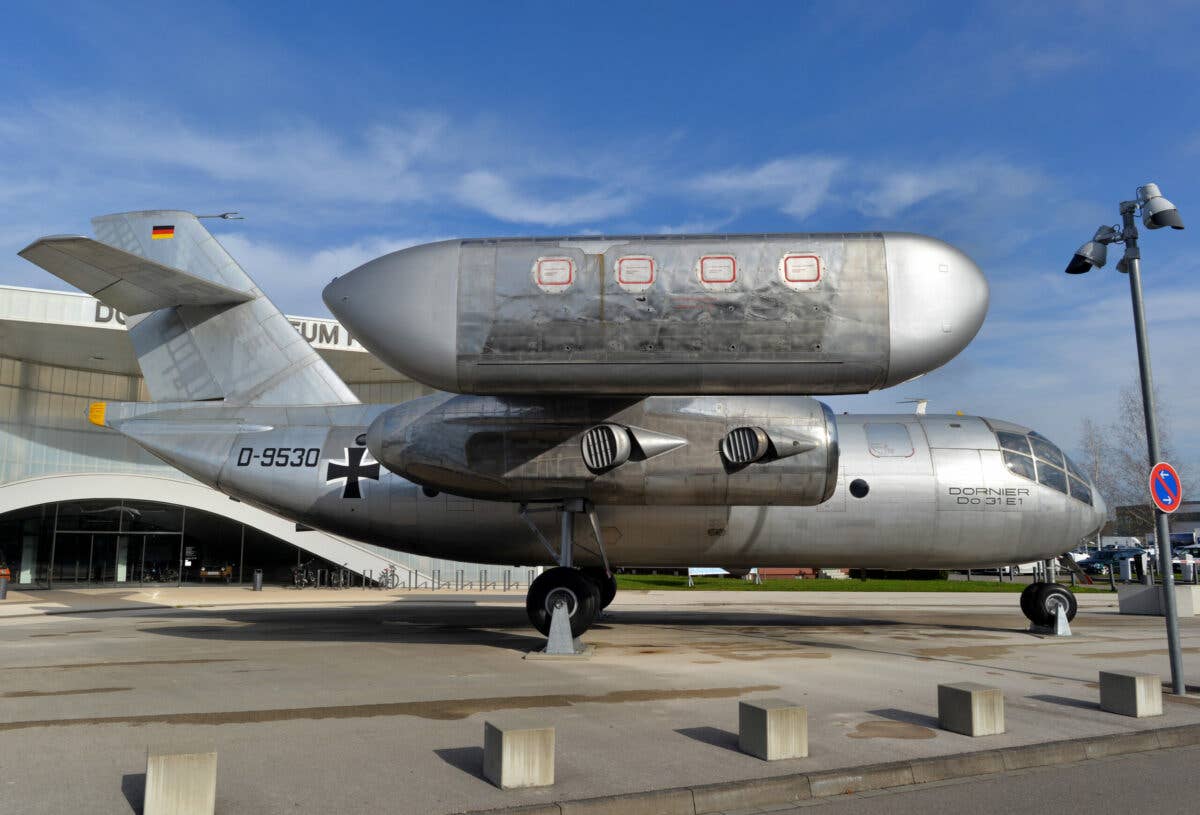Dornier Do-31: World’s First and Only VTOL Jet Transport Ever Built
The Do-31 utilized the same main engines as the Harrier, complete with their own rotatable nozzles to control direction during vertical flight.

The Dornier Do-31 remains the world’s only VTOL jet transport. [Courtesy: Jason McDowell]
In the early 1960s, the West German government presented aircraft manufacturer Dornier with a daunting challenge. Concerned that a conflict might destroy existing runways and render its airfields unusable, authorities asked Dornier to develop a vertical takeoff and landing (VTOL) transport aircraft. With significant experience developing unconventional aircraft, Dornier rose to the challenge and began designing what would become the Do-31, a transport jet capable of carrying 36 troops at speed up to 351 knots at 35,000 feet.
At the time, jet-powered VTOL aircraft had successfully flown, but all were smaller tactical and experimental types. Hawker had successfully built and flown the P.1127, which evolved into the Harrier attack aircraft. Other manufacturers had built similarly small VTOL jets, such as the Dassault Balzac V, the Short SC.1, and the EWR VJ 101. But no manufacturer had successfully integrated VTOL capability with a cargo platform.
Recognizing that engines are often the element that makes or breaks a design and budget, engineers first evaluated the existing market to see what, if any, off-the-shelf engines could be utilized. With such a limited selection of usable options, it didn’t take them long to decide on the Rolls-Royce Pegasus turbofan—as used in the Harrier—for the Do-31’s main powerplants. Unlike the Harrier, however, the engines would be mounted in underwing nacelles like modern turbofans.
Each underwing Pegasus incorporated two inboard and two outboard rotatable nozzles for control. With two wing-mounted engines suspending the aircraft in vertical flight, a significant challenge presented itself—how to maintain altitude and control in the event of an engine failure? Unlike propeller-driven designs like the Boeing MV-22 Osprey and like Dornier’s own Do-29, there was no feasible manner of mechanically transferring engine power from one wing-mounted engine to the other.
Dornier’s solution was to add additional engines. Many of them, in wingtip pylons. Engineers weren’t able to find a suitable off-the-shelf option, and thus, Rolls-Royce was contracted to design and build the RB.162 turbojet specifically for the Do-31.
The diminutive RB.162 weighed only 280 pounds but produced 4,409 pounds of thrust—more thrust than the engines utilized on the Hawker 800 business jet. Dornier placed four of these wingtip lift engines in each wingtip pylon. This satisfied the Do-31’s thrust requirements, but more importantly, it enabled the aircraft to remain flyable and controllable even in the event of a main engine failure.
As outlined by NASA in a flight evaluation, the effect of a wingtip lift engine failure would be small and easily compensated for by the remaining engines. But even one of the main Pegasus engines failed, NASA found that “the aircraft can be balanced and a thrust-weight ratio in excess of 1 can be developed.” A look at the reference charts indicates this would only be true in cooler temperatures, but it nevertheless proves the design concept.
By rotating the main engine nozzles forward and aft, and by adjusting the power of the smaller wingtip lift engines, roll and yaw could be controlled. For pitch, bleed air from the main engines was plumbed to multiple nozzles in the tailcone. These nozzles would emit bleed air upward or downward to match the desired pitch control inputs of the pilot.
Dornier ultimately succeeded in flying the 49,500 pound Do-31 both in the traditional fixed-wing aircraft regime as well as in VTOL flight. Two flying examples were built and went on to perform a variety of demonstrations and even set several world records. The technical and financial demands of procuring and maintaining the Do-31 proved to be insurmountable, however, and the project was abandoned in 1970.
Fortunately, both flying examples were preserved, and remain on display at the Dornier Museum in Friedrichshafen, Germany, and at the Deutsches Museum Flugverft Schleissheim near Munich. To this day, the Do-31 remains the first and only VTOL jet transport ever built.

Sign-up for newsletters & special offers!
Get the latest FLYING stories & special offers delivered directly to your inbox






